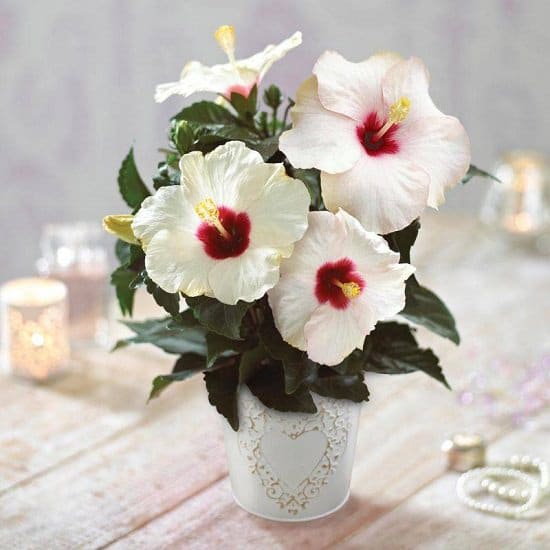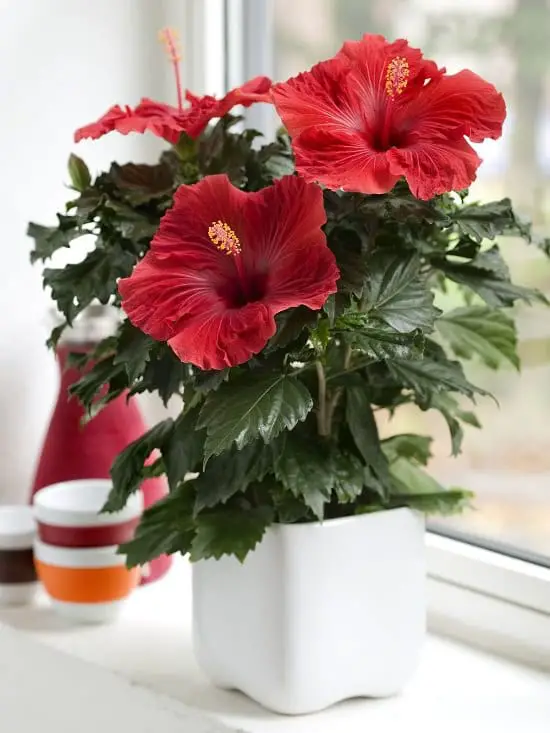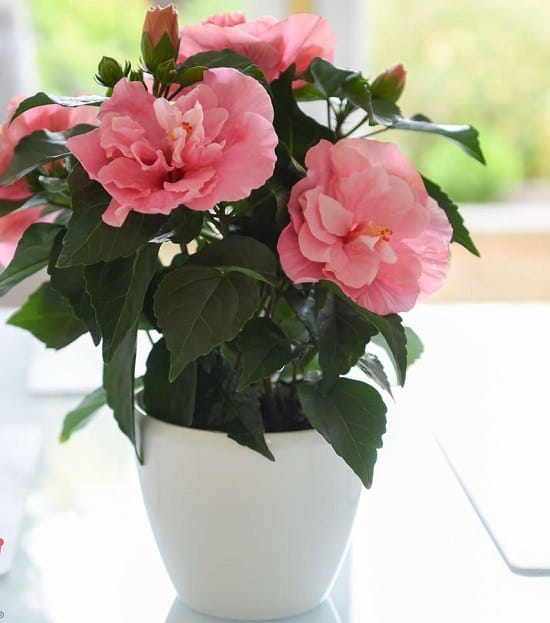Growing Hibiscus Indoors and its care is not a difficult task if you know how to do it the right way! Learn everything in detail in this article!

Hibiscus plants (Hibiscus rosa sinensis) have large and showy flowers, that makes them one of the top houseplants! To grow them successfully indoors, you have to be aware of certain things, which we are going to discuss. Read on the article to know more about growing Hibiscus indoors!
Check out our article on fast-growing indoor plants here!
How to Grow Hibiscus Indoors
Hibiscus Propagation
You can have more hibiscus plants from soft stem cuttings and air layering. However, most of the gardeners mainly use only the stem cuttings. Growing using this method produces an exact copy of the parent plant.
Start propagation in spring or early summer, by taking 4-6 inches long stem. Cut any flowers, leaves, or buds on the bottom of the stem. Apply a rooting hormone on the ends of the cutting with a cotton swab. Plant the cutting into a pot in the moist potting mix; to retain the humidity. You can also cover the propagating hibiscus with a plastic bag.
Place it in a warm area where the temperature is above 55 F (12 C) in a dappled-light, as full sun can be harmful at this point. When you notice new leaves (it generally takes 4-8 weeks), it indicates the cutting is rooted. You can then plant it in a bigger pot.
Also Read: Growing Amaryllis Indoors
Hibiscus Varieties to Grow Indoors

There are 200 species of hibiscus that are annuals, perennials, trees, and shrubs, but not all of them can be grown as houseplants. Only those that are smaller and compact in size are good for this purpose. Search for dwarf hybrid cultivars that grow 2-3 feet tall.
Some of the best hibiscus varieties to grow indoors are bahama mama, beachside bubbly, blushing bellini, cherry mojito, island hurricane, sex on the beach, rum runner remix, and sunrise mimosa.
Choosing a Pot
Pick a pot with sufficient drainage holes, preferably a beautiful one, as it is going to enhance the look of the plant further! A pot that is at least 8-10 inches deep is good enough for a dwarf hybrid variety.
Requirements for Growing Hibiscus

Light
The main reason behind a hibiscus plant, not flowering is insufficient light. Proper sunlight helps it to set buds and also gives the plant a capability to resist cold temperatures. Always place it by South or Southwest facing window, as the plant needs 5-6 hours of full sun per day.
Water
Hibiscus need a lot of watering when it is at the flowering stage. Water the plant regularly in the summer, but proper drainage is a must, as the plant dislikes soggy soil. During winter, allow the soil to dry completely before watering again.
Note: If you notice the plant wilting, it may be due to a lack of enough water.
Soil
Use a well-drained potting soil. Make sure the plant is not tightly packed, as it will interrupt the drainage. Poor drainage can result in root rot, killing the plant slowly. For best results, use 2 parts of regular potting soil and peat moss along with 1 part vermiculite or perlite.
Temperature
The ideal temperature for the hibiscus is between 55-75 F (12-24 C). Moreover, many varieties can easily tolerate hot weather above 100 F (38 C), since it’s a tropical shrub. Move your outdoor hibiscus plant inside when the temperature is constantly below 55 F (12 C). Nighttime temperature below 50 F (10 C) can damage the plant.
Indoor Hibiscus Care
Fertilizer
Hibiscus plants are heavy feeders but when you are growing them indoors, you will need to fertilize them moderately. Use all-purpose fertilizer when the plant is established and you notice new growth. Feed every 4 weeks during the growing season, reducing it in late fall and winter. Stop fertilizing from October until the end of February in cold climates. You can also add compost, rich in potassium, to the soil.
Repotting
Avoid using a too big container, as the plant, then, is going to spend its energy on the development of roots. Signs like overcrowded roots and thirsty plant are an indication that it needs repotting. Generally, re-pot it every one to two years.
Pruning
Hibiscus flowers at the branch tips, which makes many gardeners hesitate in pruning the plant. Pruning will remove some of the flowers to come and new branches will take a few months to produce new flowers after pruning.
On the other hand, if you skip it, the plant will become overgrown and gawky. Prune one-third of the selected and crowded branches, once or twice a year. It is going to stimulate the branching of the plant, making it look fuller.
Note: Indoor hibiscus doesn’t require as much pruning as an outdoor one.
Also Read: Growing African Violet Indoors
Pests and Diseases
Hibiscus plants may suffer from mealybugs, they love it. Then there are aphids, whiteflies, and red spider mites, they’re fond of it too. To keep the plant healthy and free from pests, provide it enough light and air circulation. You can spray the plant with insecticidal soap and repeat it every 3-5 days until you notice no more pests.
In diseases, your indoor hibiscus may suffer from root rot, if you’ll water it too often and keep the soil overly moist for a long time. To avoid it, it’s better to water only when the soil is slightly dry.



